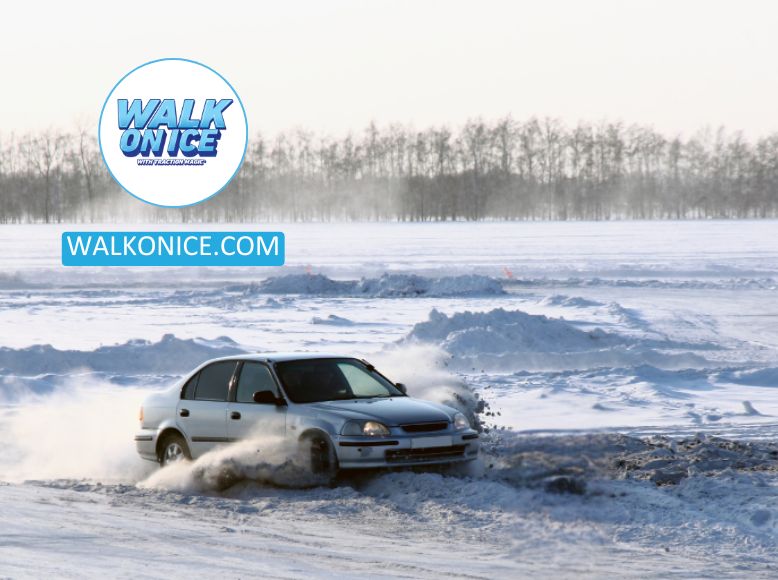6 Ways To Improve Traction On Ice For Safety And Stability

Hey, winter warriors! Let’s huddle up and talk about the great icy obstacle course that is winter. We all know the drill: you step outside, and whoops – it’s an ice rink out there. Time to brainstorm some clever (and sometimes quirky) ways to boost that traction on ice. Picture this: you, confidently striding over ice, no slips, no slides. Sounds good, right? Let’s dive into six nifty tricks to keep traction on ice and maybe even chuckle at the challenge. And yep, I’ve got a secret ace up my sleeve called ‘Walk On Ice.’
1. The Right Footwear: No More Ice Skating In Sneakers
First off, let’s talk boots. It’s all about the grip – like those amazing non-slip shoes chefs wear, but winter-style. Deep treads, or even better, some clever add-on cleats, can turn your regular boots into ice-conquering heroes. Because let’s face it, ice skating in sneakers is only fun in cartoons.
2. Waddle Like A Penguin: Embrace The Wobble
Ever seen a penguin slip on ice? Nope, me neither. There’s a trick to their toddle – short steps, feet apart, and a bit of a forward lean. It’s not the most graceful look, but hey, neither is landing on your backside. So, channel your inner penguin and embrace the waddle!
3. Kitty Litter And Sand: The Unsung Heroes
For those sneaky icy patches right outside your door, kitty litter or sand can be a game-changer for traction on ice. They’re like the understudies in the play of winter – not the star performers, but they sure can save the show when it comes to traction.
4. The Salt Story: Not Always The Good Guy
Ah, salt. The classic ice melter. But when it comes to traction, it can leave you high and dry (or should I say, high and slippery?). Plus, it’s not exactly a friend to your yard or your pets. It’s like that strong dish soap that promises to be gentle but leaves your hands feeling like sandpaper.
Get ready for winter with Walk On Ice instant traction on snow and ice
5. ‘walk On Ice’: The Cool New Kid On The Block
When the going gets icy, ‘Walk On Ice’ gets traction on ice. This isn’t your run-of-the-mill ice melt. It’s all about giving you instant, reliable traction. Think of it as your personal ice bodyguard, making sure you walk safely on ice without any drama. It’s pet-friendly, eco-friendly, and basically like having winter superpowers in a can.
6. The Art Of The Careful Stride
Lastly, a big part of staying upright is just taking it easy. Slow down, keep your hands free (sorry, no texting and walking!), and always watch where you’re stepping. It’s like navigating a tightrope – focus and balance are key.
When Roads Freeze: What Temp Does Ice Form On Roads?
After all this talk about walking safely, let’s not forget about what happens when we’re behind the wheel. You may wonder, what temp does ice form on roads? Most people assume it’s always at the classic freezing point—32°F (0°C)—but in reality, ice can sneak up on you sooner than that. If the road surface is cooler than the air, ice can form even when your car’s dashboard thermometer says 34°F. Bridges, shaded stretches, and spots with poor drainage freeze first, turning into hidden danger zones. That’s why slowing down and scanning the road is just as important as watching your step.
Stuck Tires? Here’s How To Get Out Of Deep Snow
Even the best winter driver has been there: wheels spinning, car going nowhere, frustration rising. So, how to get out of deep snow without calling a tow truck? First, resist the urge to floor it—spinning only digs you deeper. Instead, clear snow away from your tires with a shovel (or even your boots if that’s all you’ve got). Next, place something gritty like sand, old floor mats, or even kitty litter under the tires for extra grip. But if you’re reaching for litter, keep in mind that not all kinds work the same—silica cat litter, for example, has an environmental downside and can get messy. A natural traction agent like Walk On Ice is cleaner and works instantly. With the right traction and a little gentle rocking between forward and reverse, you’ll be free before your fingers freeze.
Wooden Stairs Anti Slip: A Winter Upgrade Worth Considering
Driveways and sidewalks get most of the attention, but wooden stairs can be silent culprits in winter accidents. Smooth wood gets slick when wet, and add a layer of frost or ice? Instant hazard. That’s where wooden stairs anti slip fixes come in handy. Rubber treads, adhesive grip tape, or outdoor stair mats can dramatically improve stability. For pet owners, this is especially helpful—dogs often struggle on slippery stairs. Sprinkle a bit of traction material before heading out, and you’ll avoid the morning slide. Think of it as winter-proofing your front porch as much as your driveway.
The Messy Reality: Silica Cat Litter Environment Concerns
Earlier we touched on kitty litter as a makeshift traction tool, but let’s get real about its downsides. Traditional silica cat litter is not exactly eco-friendly. Once scattered on ice and snow, it doesn’t break down easily and can end up clogging drains or spreading dust that isn’t great for the environment. Clay-based litter isn’t much better—it turns into a sticky paste once wet. Sure, kitty litter might help in a pinch, but if you’re using it on your driveway every winter, the buildup is going somewhere, and often not where you want it. Switching to a natural, mineral-based traction agent is not just about safety, but also about being responsible with what gets left behind once the ice is gone.
Walking, Driving, And Staying Upright—It’s All Connected
What’s interesting about winter safety is how all these situations—slippery stairs, frozen driveways, stuck cars—are connected by one simple concept: traction. Whether you’re asking how to walk on ice without falling, how to get out of deep snow, or what to do when black ice forms on roads, the answer always circles back to having grip where you need it most. And while old-school fixes like sand or kitty litter still have their place, newer solutions like Walk On Ice make it possible to tackle multiple problems with one product—safer steps, safer tires, and safer walks for both people and pets.
Conclusion: Mastering Winter With Knowledge And Grip
Winter safety isn’t just about bracing for the cold—it’s about anticipating the slippery surprises it brings. We’ve covered not only how to improve traction under your feet but also how to keep your tires moving when you’re buried in snow, how thick ice needs to be before you trust it, and even why your wooden stairs deserve as much anti-slip attention as your driveway. Understanding details like what temp does ice form on roads or the environmental cost of silica cat litter gives you a sharper edge in staying prepared.
Pair that knowledge with practical tools—like stair treads for your porch or Walk On Ice for instant grip—and you’ll find yourself walking, driving, and even shoveling with a whole lot more confidence. Winter won’t stop being slippery, but with the right mix of preparation and traction, you don’t have to be caught off guard.
Other Ice Melt Products
Safe Paw
The Original and #1 Selling Pet and Child Safe Ice Melt for over 20 years. Guaranteed environmentally safe – will not harm waterways and sensitive wetlands. All products are made in the USA.

Safe Thaw
Imagine an ice melt you can put down and never worry about. It won’t harm pets, kids, and your property. That’s Safe Thaw. Unlike anything else on the market, Safe Thaw can change how winter affects our planet.



